Kindred Kingdoms
Fauna
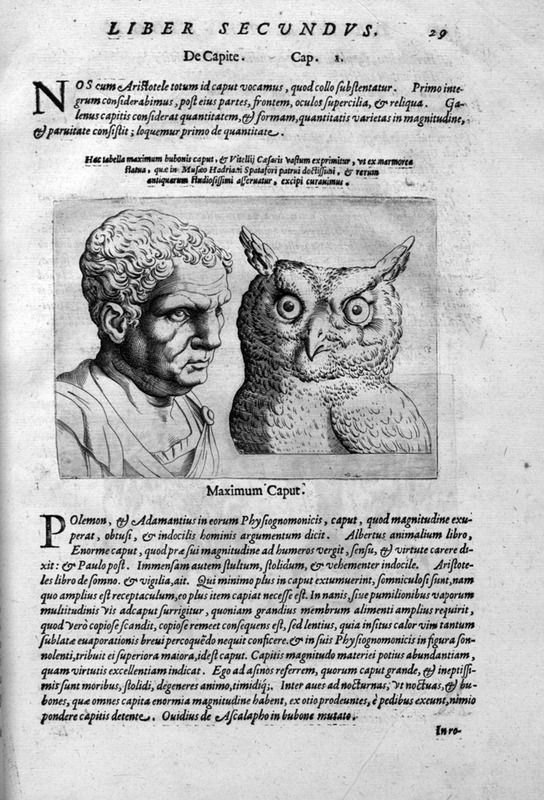
Giambattista della Porta (Italian, 1535?-1615)
De humana physiognomonia.
Vici Æquensis: Apud Iosephum Cacchium, 1586.
Special Collections & Rare Books
MU Libraries
Rare Folio BF840 .P65 1586
Kinship with animals is about recognizing a family connection between human and nonhuman animals. It recognizes difference but does not draw an arbitrary line that assigns dominion to humans over animals. Like any good relationship, a positive relationship between human and non-human animals hinges on respect for the other's being, communication, and the capacity to find the other in ourselves. Cat, dog, human, mouse, lizard, are categories. Ask the animal "Who are you really, in your own being?"
Lee Spark Jones, Kinship with Animals, 2004.
In the second half of the sixteenth century, a hundred years after Gutenberg set up the first printing shop, presses led to the wide dissemination of all sorts of knowledge. Interestingly enough, physicians were among the most published lay authors of the time. They were obviously interested in the nature of man, his place in the natural world and relations with flora and fauna. This case displays De Humana Physiognomonia of Giambattista della Porta, an Italian scholar, alchemist and polymath, published in 1568. This work draws on the pseudo-science of physiognomy, which held that a person's character could be determined from his or her outward appearance. In this publication, della Porta compares human and animal faces, claiming that visual similarities revealed underlying temperamental commonalities among animals and human beings. Della Porta thought that a man resembling a donkey was like a donkey: timid, stupid, and stubborn, whereas the horse, a noble animal, makes it dignified for a man to walk erect with his head held high.
We also show here various animal encyclopedias and scholarly works on fauna. Among them there is a sixteenth-century pioneering work by the Swiss physician and scholar Conrad Gessner, Historia Animalium(1551-1558). It was the first illustrated encyclopedia of all known (or little known) animals. Readers were surprised or amused by the looks of the quite anthropomorphic "Monk Fish" and "Bishop Fish", smiling mammals of the "New World," or a unicorn. One can see in our exhibit the book on marine animals by Gessner's contemporary, the French physician, naturalist and poet François Boussuet, De natura aquatilium carmen (1558). To continue our theme of kinship in the animal kingdom, we show here a charming children's Kellogg's Jungle Book (1909) with the heads of one set of animals interchangeable with the feet of others.
Gallery
Click the images below for more details.
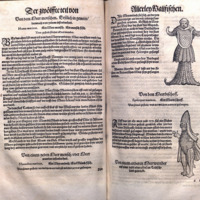
Conrad Gessner (Swiss, 1516-1565)
Thierbuch: das is ein kurtze B[e]schreybung aller vierfüssigen Thieren.
Zürich: Christoffel Forschower, 1563.
Special Collections & Rare Books
MU Libraries
Rare Vault QL41 .G4715 1557
A doctor, philosopher, botanist, and classicist, Conrad Gessner was a polymath perhaps best known today for his groundbreaking work in zoology. His Historia Animalium was an attempt to describe and classify all known animals on the basis of their behavior and their relationship to humans. The copy on display here is an example of the German edition of his Latin text.
Gessner's monk fish and bishop fish are seen in the page displayed here. Although Gessner's images differ little from Rondelet's, he distills all the information available on the creature at the time, including a few unpublished accounts and sightings.
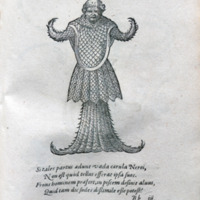
Francois Boussuet (French, 1520-1572)
De natura aquatilium carmen.
Lyon: Matthiam Bonhome, 1558.
Special Collections & Rare Books
MU Libraries
Rare QL41 .B67 1558
Very little is known about Francois Boussuet. Like many other early biologists, he was also a medical doctor. This work was a summary in epigrams of Guillaume Rondelet's treatise on animals of the sea, which became a standard reference work on marine life.
One of Rondelet's claims to fame was publishing the first likeness of a sea monster he called a monk fish, which had been caught off the coast of Norway around 1550. Rondelet was dismayed to find that his friend Conrad Gessner had other images of the so-called monk fish, and that they differed from his own.
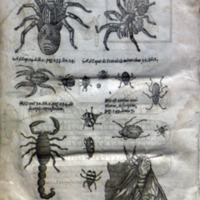
Thomas Moffett (British, 1553-1604)
Insectorum sive minimorum animalium theatrum.
London: T. Cotes, 1634.
Special Collections & Rare Books
MU Libraries
Rare Folio QL463 .M93
Thomas Moffett or Muffet was an English naturalist and physician. He edited the Insectorum sive minimorum animalium theatrum (Theater of Insects), which was an encyclopedia of insects and their behavior based on previous scientific works. Moffett added commentary on the beauty and virtue of insects and the lessons they could teach humans. Moffet wrote:
Do you require Prudence? regard the Ant; Do you desire Justice? regard the Bee; Do you commend Temperance? take advice of them both. Do you praise Valour? See the whole generation of Grasshoppers.
Moffett was particularly interested in spiders. In fact, the nursery rhyme "Little Miss Muffet" is said to have been written about an incident involving one of his children.
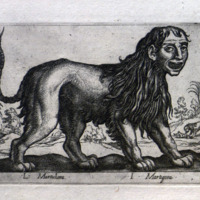
Antonio Tempesta (Italian, 1555-1630)
Noua racolta de li animali piu curiosi del mondo.
Rome: G. J. Rossi, 1650.
Special Collections & Rare Books
MU Libraries
Rare NE962.A5 T5
Antonio Tempesta was a well-known Florentine painter and engraver. This book is a collection of engravings of animals, produced by Tempesta and published by Giorgio Jacomo Rossi after Tempesta's death. Like many works of this period, this book features hybrid human-animal monsters. One of the plates illustrates a manticore, a mythical creature with the head of a man, the body of a lion, the teeth of a shark, and the tail of a scorpion. According to Roman and medieval sources, the monster could shoot poisonous darts from its tail and had an appetite for human flesh.
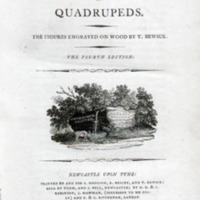
Ralph Beilby (British, 1743-1817) and Thomas Bewick (British, 1753-1828)
A General History of Quadrupeds.
Newcastle upon Tyne: Printed by and for S. Hodgson, R. Beilby, and T. Bewick, 1800.
Special Collections & Rare Books
MU Libraries
Rare QL706 .B5 1800
The illustrations for this book were created by Thomas Bewick, one of the finest English engravers of his time. This book reflects an increased interest in natural history and the animal kingdom during the end of the eighteenth century and was a source of information for many readers during his lifetime.
Bewick engraved the figures from life wherever possible, but he was unable to observe the more exotic creatures in person. He reproduced many of the animals from William Smellie's 1781 English translation of Buffon's Histoire naturelle.

George-Louis Leclerc, Comte de Buffon (French, 1707-1788)
Histoire naturelle, générale et particulière, avec la description du Cabinet de roi.
Paris: De l'Imprimerie royale, 1749-1803.
Special Collections & Rare Books
MU Libraries
Rare QH45 .B78 1749
Born to middle-class parents, George-Louis Leclerc became one the most widely read authors of the eighteenth century. Due to his scientific work at the Jardin du Roi, he was made the Count of Buffon by Louis XV in 1772. Histoire naturelle was his attempt to classify and describe all living things.
Buffon's ideas about the kinship of living organisms were complex and problematic, but they paved the way for later scientific thought. Although Buffon himself was not an evolutionist, he was among the first to raise the questions that led to a theory of evolution and the recognition of shared ancestry among different species. Buffon believed in monogenesis — the idea that all human races are related through a single origin — although he denied that humans could be descended from apes.
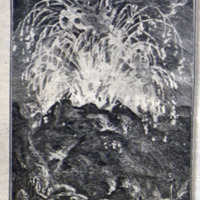
Oliver Goldsmith (British, 1730-1774)
A History of the Earth and Animated Nature.
London, F. Wingrave, 1791.
Special Collections & Rare Books
MU Libraries
Rare QL50 .G62 1791
Oliver Goldsmith was a novelist, not a scientist, but that did not stop him from writing one of the most popular works on natural history in the Victorian era. A History of the Earth and Animated Nature attempts a holistic and encyclopedic treatment of life on this planet, from the tiniest one-celled organisms to the human species.
Unlike many anthropologists of the time, Goldsmith believed in monogenesis — the idea that all humans are related to each other as members of the same species. Goldsmith even went farther and argued that humans are members of the animal kingdom, not a separate and superior creation as was commonly believed.

J. J. Grandville (French, 1803-1847)
Un autre monde.
Paris: H. Fournier, 1844.
Special Collections & Rare Books
MU Libraries
Rare NC1499.G66 A42
Un autre monde is a collection of satirical works, many of which use anthropomorphic plants and animals to accentuate political commentary. Grandville is famous for his pictorial wit, humor, and lampoonery.
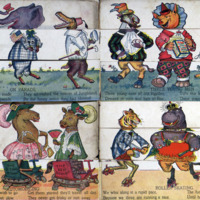
Kellogg's Jungle Book.
Battle Creek, Mich.: W.K. Kellogg, c1909.
Special Collections & Rare Books
MU Libraries
Rare PZ7 .K295 1909
This toy book was created by the Kellogg Company, the manufacturer of breakfast cereals. The book features animals in human clothing on the cover. The pages are cut into segments, allowing the reader to manipulate the appearance of the animals by matching different heads, bodies and feet.
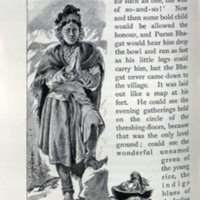
Rudyard Kipling (British, 1865-1936)
The Second Jungle Book.
London; New York: Macmillan, 1895.
Special Collections & Rare Books
MU Libraries
Rare PR4854 .J63
Rudyard Kipling's classic The Jungle Book contains a number of stories about the relationships between humans and animals. One of the most famous tales chronicles the life of Mowgli, a young boy raised in the jungle by various animals. The Second Jungle Book contains several additional stories of Mowgli, his animal family, and his attempts to re-enter human society.

Allen Grant Wallihan (American, 1859-1935) and Mary A. Wallihan (American, born ca. 1844)
Hoofs, Claws and Antlers of the Rocky Mountains.
Denver, Col.: F. S. Thayer, 1902.
Special Collections & Rare Books
MU Libraries
Rare QL706 .W22
Allen Grant Wallihan and his wife Mary produced at least two photography books documenting large game animals in the wild. The Wallihans were known as detailed observers of nature, and many of their images put wildlife in juxtaposition with humans.
Although the Wallihans noted the destructiveness of human encroachment on wildlife, they were also avid hunters. Mary Wallihan was an amazing markswoman; she reportedly took out two deer with one shot from a distance of over 100 yards on one occasion. In this plate, she poses with her thirtieth deer.
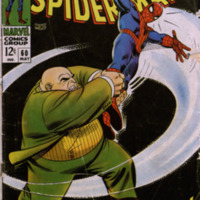
The Amazing Spider-Man.
New York: Non-Pareil Pub. Corp., 1962-
Special Collections & Rare Books
MU Libraries
Comic PN6728.3.M3 A5 no.60 May 1968
In the world of comic superheroes, interaction among humans and animals often takes a fantastic turn. Peter Parker, a geeky high school student, is bitten by a radioactive spider at a science museum. The spider's bite imparts supernatural powers, including the strength and characteristics of an arachnid. Peter uses these powers to fight crime as the Amazing Spider Man. The character has been featured in numerous comics, books, movies and TV shows since the early 1960s.
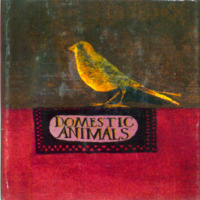
Leonard Baskin (American, 1922-2000)
Miniature Natural History: First Series.
New York: Pantheon Books, 1983.
Special Collections & Rare Books
MU Libraries
Rare QL46 .B25 1983
Leonard Baskin was a sculptor, printmaker and book illustrator whose works gained wide recognition in the twentieth century. His Miniature Natural History contains four small volumes with illustrations of various animals and no text. The volumes are titled Seven fish, one crab, one lobster, one octopus & one prawn; Insects; Domestic animals; and Extinct creatures. Although Baskin uses the encyclopedic term "natural history," the presentation and limited scope of these books question the extent of human knowledge about animals.